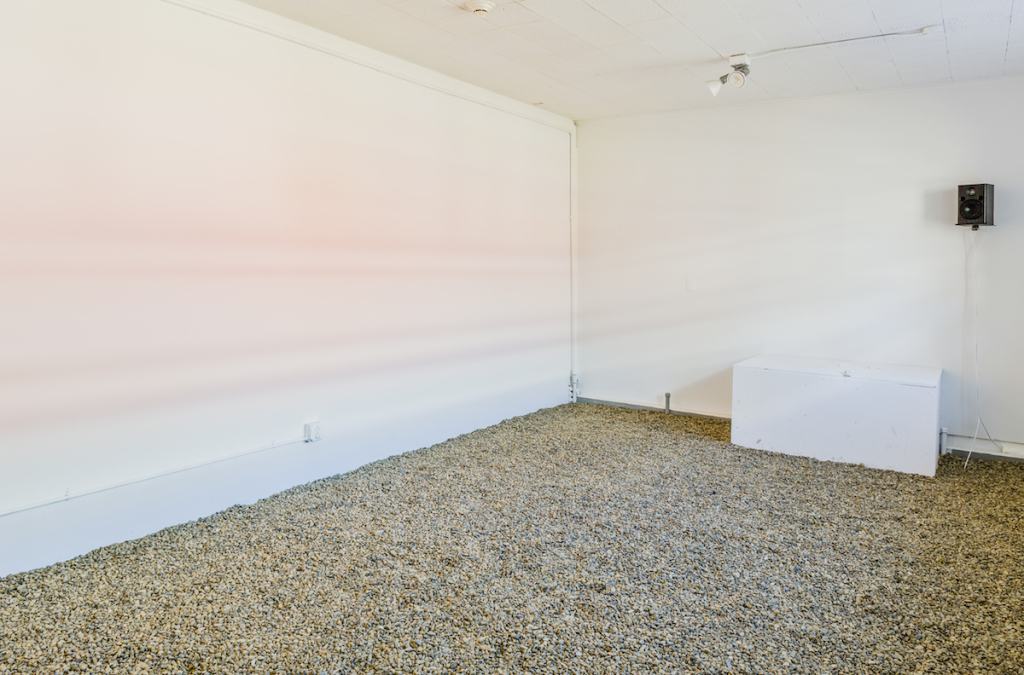
Photo by Phoebe d’Heurle
Is it possible to provoke an embodied sense of place in a site that doesn’t know whether it is fake or real?
Looking back at images from a recent installation — and listening to its sound — I’m trying to remove the memory of this specific place, replacing it with the memory of its media. Listening and looking, and staring at the screen — trying to recall whether it was important or not to be living in that space, experiencing the flow of time, then and there. I partly want to believe that this place is inherently site-specific —while at the same time insisting that it can travel freely through its virtual displacement—similar to how we experience any kind of documentation of art; a picture of a room, a description of an action, a list of materials, etc.
After all, my desire to express something here remains the same as when I began installing this work — to use an incidental site to explore the effects of sonic displacement, merging the perceived “real” with its copy. If a sound can be heard “acoustically” and from shifting perspectives — the sound of footsteps on gravel, the sound of gravel recorded (and re-recorded) playing from speakers both inside and outside — why not compress the entire site into a document? Are we still in the Rock Room? Can we enter the Rock Room here and now? Perhaps through one of these rays of red light?

Photo by Pete Mauney
Materials necessary for the continuation of Rock Room in a new site:
3/4” gravel (or something sonically equivalent)
1 (or more) audio playback device(s)
1 audio recording device
1 pair of headphones
additional amplifier and/or speakers (optional)
pre-recorded audio (below)
Instructions:
I recommend entirely covering the floor of a room with small rocks or gravel. It should be an inch or two deep.
If inconvenient, search for material with a complementary sound, or find a location that already meets these requirements—a suburban driveway, a rocky path, or institutional landscaping all seem to work well.
If you are indoors, open the windows.
Next, play back the audio provided in the above link.
The audio itself can be used in many ways.
Here, it is presented as a stereo file, but it can also be split into two separate mono channels, as it was originally used. The sound itself is nothing more than a compression of individual experiences—a series of walks, mainly.
Play the sounds out of whatever is available— car radio, phone, stereo, etc.
Inhabit this space for a while, and make sure to get the mix right—so that the recorded sounds blend nicely with your surroundings. If you begin to question what is recorded and what isn’t, that is a good sign!
I suggest keeping it as quiet as can be while still effective.
Once you’ve achieved a good mix, listen carefully to any significant differences between the recorded and “live” sound. Pay attention to the particular sounds of the space you’re in.
Now, put on a pair of headphones and record the sound around you while the original track is playing. When you’re finished, listen back to the recording.
If it sounds satisfactory, repeat this process with this new track replacing the original.
Listen to the sounds that fade away, and the sounds that enter the foreground.
Repeat.

Jamie Kelly, left, and Geoff Mullen, right, shovel dry gravel into wheelbarrow for transport. Photo by Anton Ginzburg
Geoff Mullen is an artist & musician from Providence, Rhode Island. Recent projects have included site-specific installation, sculpture, photography & video, collage, educational workshops, and performance. Geoff has presented work throughout the USA, Canada, and Europe—in venues ranging from concert halls, clubs, museums, galleries, basements, schools, streets, and city gardens. His music has been released on most available audio media, and he is the founder of Rare Youth, an independent record label dedicated to the support of local (RI) underground music. Geoff completed his MFA at Bard College, and is currently a faculty member at the Massachusetts College of Art & Design. http://www.geoffmullen.com/